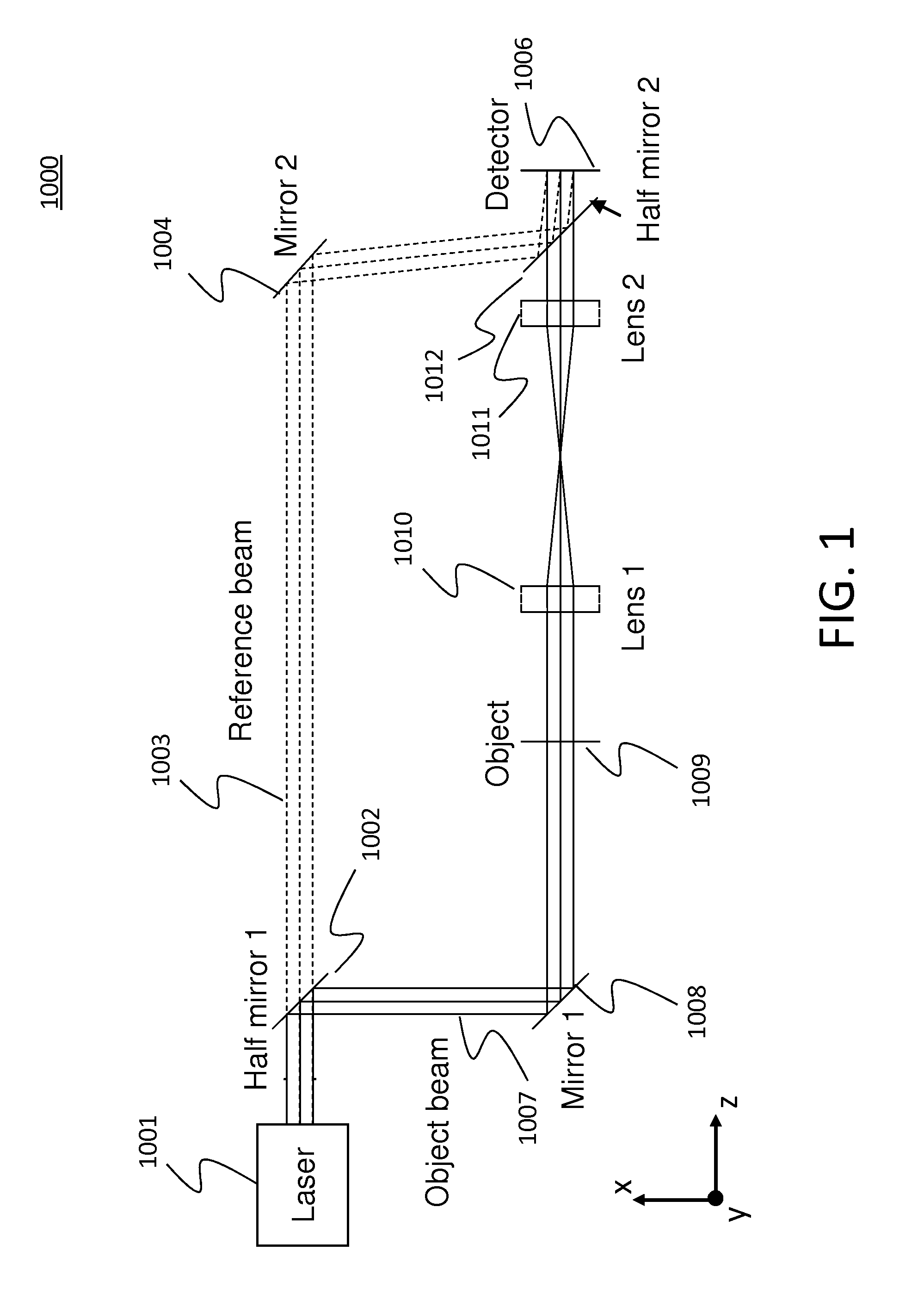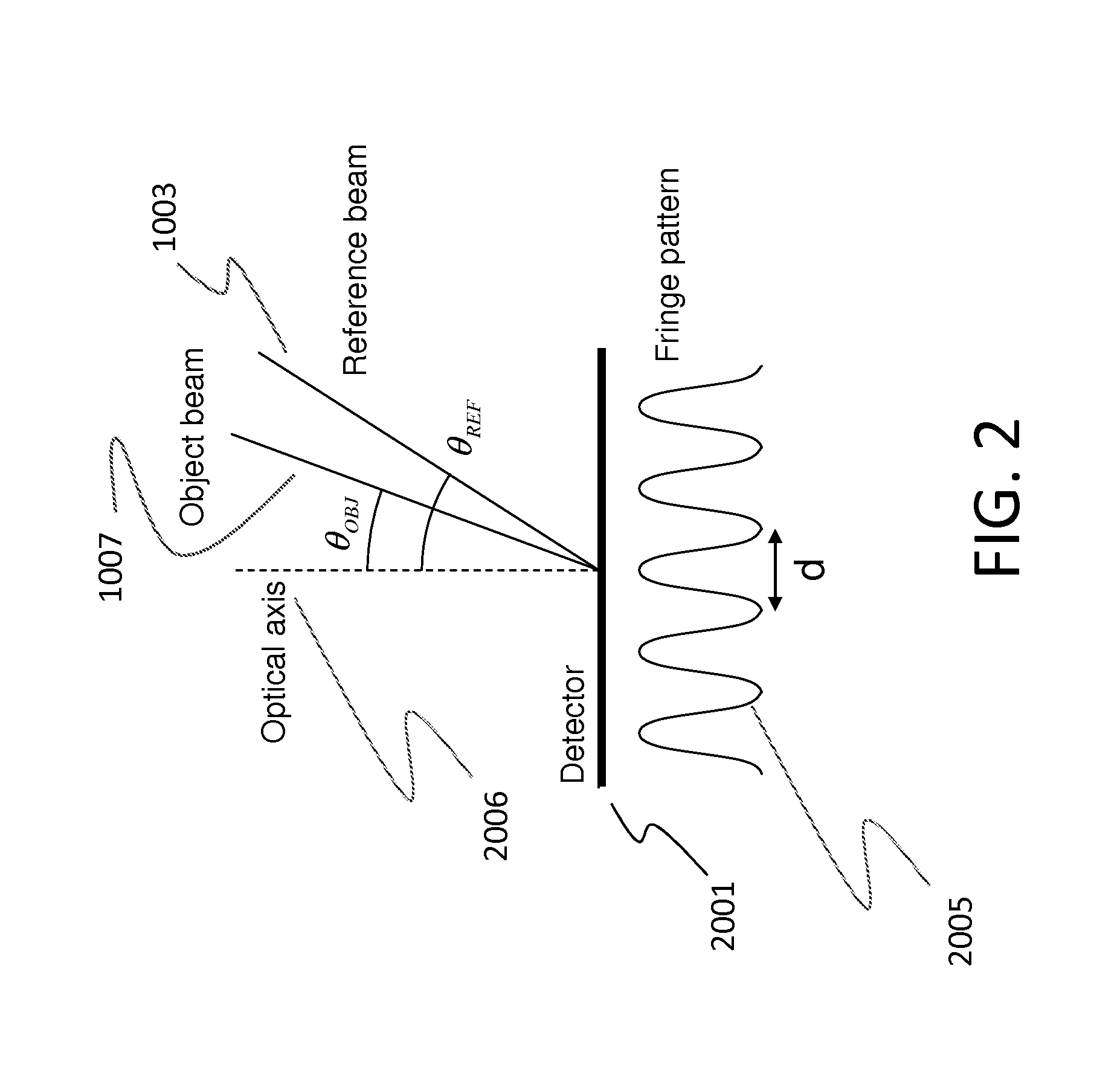Interferometric method and digital holographic microscope
a technology of interferometry which is applied in the field of interferometry methods and digital holographic microscopes, can solve problems such as unmaturized techniques
- Summary
- Abstract
- Description
- Claims
- Application Information
AI Technical Summary
Benefits of technology
Problems solved by technology
Method used
Image
Examples
first embodiment
Circular Scan
[0056]A system 1000 for performing the off-axis method is illustrated in FIG. 1. A display and a computer, which are not shown, can be used as the digital holographic microscope. A beam from a laser 1001 is split into a reference beam 1003 and an object beam 1007 by a half mirror 1002. The reference beam 1003 travels to the detector 1006 via a mirror 1004 and a half mirror 1012. As shown in FIG. 1, the object beam 1007 travels to an object (sample) 1009 via a mirror 1008. The object beam 1007 then travels through the object 1009 to the detector 1006 via two lenses 1010 and 1012, and a half mirror 1012. The object can be, for example, living or non-living cells, tissues, or organisms.
[0057]The phase information of the object 1009 is measured as an interference pattern (i.e., a fringe pattern) formed by the object beam 1007 and the reference beam 1003. To form the interference pattern on the detector 1006, the reference beam 1003 is not perfectly parallel to the object be...
second embodiment
Spiral Scan
[0110]The following configuration in this embodiment is based on the off-axis method.
[0111]In FIG. 20, a system 2800 separates an incident light emitted from a laser source 2801 into two beams by a first beam splitter 2802, and integrates them by a second beam splitter 2812. Lens units (2814, 2815, 2816, and 2817) can be used in the system. One beam can be called an object beam 2807, and the other can be called a reference beam 2803. A sample 2809 is located at the object beam side. The object beam 2807 is tilted by a Galvanometer mirror 2808. This tilt makes an angle between the object and reference beams on the detector 2806 in order to generate fringe patterns on the detector 2806. The fringe pattern is recorded as digital holograms.
[0112]By changing the angle of the Galvanometer mirror 2808, the incident angle of the object beam 2807 against the sample 2809 can be controlled. By controlling this incident angle, the sample 2809 can be scanned with a lot of angles so th...
third embodiment
Scanning Both Beams
[0126]In this embodiment, a method for controlling an angle of the reference beam while changing an illumination angle of the object beam is described.
[0127]In FIG. 27, the off-axis holography system 2700 is illustrated. A beam from a laser source 2701 is split into an object beam 2709 and a reference beam 2703 by a half mirror 2702. The object beam 2709 travels to a detector 2707 via a scanning mirror 2710, a lens 2711, a lens 2712, an object 2750, a lens 2713, a lens 2714, and a half mirror 2708. The reference beam 2703 travels to the detector 2707 via a scanning mirror 2704, a lens 2705, a lens 2706, and the half mirror 2708. A fringe pattern formed by the object and reference beams can be detected by the detector 2707.
[0128]Lenses 12711 and 22712 make the mirror 2710 and the object 2750 conjugate so that tilting the mirror 2710 doesn't change the position of the beam in the object 2750. A lens 32713 is an objective lens, and a lens 42714 is a tube lens, and th...
PUM
 Login to View More
Login to View More Abstract
Description
Claims
Application Information
 Login to View More
Login to View More - R&D
- Intellectual Property
- Life Sciences
- Materials
- Tech Scout
- Unparalleled Data Quality
- Higher Quality Content
- 60% Fewer Hallucinations
Browse by: Latest US Patents, China's latest patents, Technical Efficacy Thesaurus, Application Domain, Technology Topic, Popular Technical Reports.
© 2025 PatSnap. All rights reserved.Legal|Privacy policy|Modern Slavery Act Transparency Statement|Sitemap|About US| Contact US: help@patsnap.com



